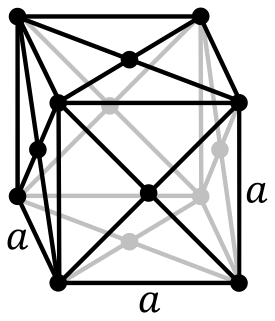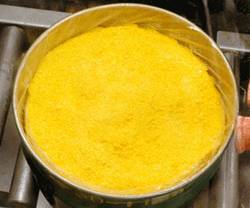Background radiation is a measure of the level of ionizing radiation present in the environment at a particular location which is not due to deliberate introduction of radiation sources.

Radon is a chemical element with the symbol Rn and atomic number 86. It is a radioactive, colorless, odorless, tasteless noble gas. It occurs naturally in minute quantities as an intermediate step in the normal radioactive decay chains through which thorium and uranium slowly decay into lead and various other short-lived radioactive elements. Radon itself is the immediate decay product of radium. Its most stable isotope, 222Rn, has a half-life of only 3.8 days, making it one of the rarest elements. Since thorium and uranium are two of the most common radioactive elements on Earth, while also having three isotopes with half-lives on the order of several billion years, radon will be present on Earth long into the future despite its short half-life. The decay of radon produces many other short-lived nuclides, known as radon daughters, ending at stable isotopes of lead.

Indoor air quality (IAQ) is the air quality within and around buildings and structures. IAQ is known to affect the health, comfort, and well-being of building occupants. Poor indoor air quality has been linked to sick building syndrome, reduced productivity, and impaired learning in schools.

The linear no-threshold model (LNT) is a dose-response model used in radiation protection to estimate stochastic health effects such as radiation-induced cancer, genetic mutations and teratogenic effects on the human body due to exposure to ionizing radiation. The model statistically extrapolates effects of radiation from very high doses into very low doses, where no biological effects are observed. The LNT model lies at a foundation of a postulate that all exposure to ionizing radiation is harmful, regardless of how low the dose is, and that the effect is cumulative over lifetime. The model is disputed and is deprecated by a number of international bodies specializing in radiation protection.
Bernard Leonard Cohen was born in Pittsburgh, and was Professor Emeritus of Physics at the University of Pittsburgh. Professor Cohen was a staunch opponent of the so-called Linear no-threshold model (LNT) which postulates there exists no safe threshold for radiation exposure. His view which has support from a minority. He died in March 2012.
Environmental medicine is a multidisciplinary field involving medicine, environmental science, chemistry and others, overlapping with environmental pathology. It can be viewed as the medical branch of the broader field of environmental health. The scope of this field involves studying the interactions between environment and human health, and the role of the environment in causing or mediating disease. This specialist field of study developed after the realisation that health is more widely and dramatically affected by environmental factors than previously recognized.

Uranium mining is the process of extraction of uranium ore from the ground. The worldwide production of uranium in 2019 amounted to 53,656 tonnes. Kazakhstan, Canada, and Australia were the top three uranium producers, respectively, and together account for 68% of world production. Other countries producing more than 1,000 tonnes per year included Namibia, Niger, Russia, Uzbekistan, the United States, and China. Nearly all of the world's mined uranium is used to power nuclear power plants.

Radium and radon are important contributors to environmental radioactivity. Radon occurs naturally in the environment as a result of decay of radioactive elements in the soil and it can accumulate in houses built on areas where such decay occurs. Radon is among the major causes of cancer; it is estimated to contribute to about 2% of all cancer related deaths in Europe.

Environmental epidemiology is a branch of epidemiology concerned with determining how environmental exposures impact human health. This field seeks to understand how various external risk factors may predispose to or protect against disease, illness, injury, developmental abnormalities, or death. These factors may be naturally occurring or may be introduced into environments where people live, work, and play.
Workplace health surveillance or occupational health surveillance (U.S.) is the ongoing systematic collection, analysis, and dissemination of exposure and health data on groups of workers. The Joint ILO/WHO Committee on Occupational Health at its 12th Session in 1995 defined an occupational health surveillance system as “a system which includes a functional capacity for data collection, analysis and dissemination linked to occupational health programmes”.
The health effects of the 1979 Three Mile Island nuclear accident are widely, but not universally, agreed to be very low. The American Nuclear Society concluded that average local radiation exposure was equivalent to a chest X-ray, and maximum local exposure equivalent to less than a year's background radiation. The U.S. BEIR report on the Biological Effects of Ionizing Radiation states that "the collective dose equivalent resulting from the radioactivity released in the Three Mile Island accident was so low that the estimated number of excess cancer cases to be expected if any were to occur, would be negligible and undetectable." A variety of epidemiology studies have concluded that the accident has had no observable long term health effects. One dissenting study is "a re-evaluation of cancer incidence near the Three Mile Island nuclear plant" by Dr Steven Wing of the University of North Carolina. In this study, Dr Wing and his colleagues argue that earlier findings had "logical and methodological problems" and conclude that "cancer incidence, specifically lung cancer and leukemia, increased following the TMI accident in areas estimated to have been in the pathway of radioactive plumes than in other areas." Other dissenting opinions can be found in the Radiation and Public Health Project, whose leader, Joseph Mangano, has questioned the safety of nuclear power since 1985.

In 1944, uranium mining under the U.S military's Manhattan Project began on Navajo Nation lands and on Lakota Nation lands. On August 1, 1946, the responsibility for atomic science and technology was transferred from the military to the United States Atomic Energy Commission. Afterward, widespread uranium mining began on Navajo and Lakota lands in a nuclear arms race with the Soviet Union during the Cold War.
Radon, a radioactive, colorless, odorless, tasteless noble gas, has been studied by a number of scientific and medical bodies for its effects on health. A naturally-occurring gas formed as a decay product of radium, radon is one of the densest substances that remains a gas under normal conditions, and is considered to be a health hazard due to its radioactivity. Its most stable isotope, radon-222, has a half-life of 3.8 days. Due to its high radioactivity, it has been less well-studied by chemists, but a few compounds are known.
Paul James Lioy was a United States environmental health scientist born in Passaic, New Jersey, working in the field of exposure science. He was one of the world's leading experts in personal exposure to toxins. He published in the areas of air pollution, airborne and deposited particles, Homeland Security, and Hazardous Wastes. Lioy was a Professor and Division Director at the Department of Environmental and Occupational Health, Rutgers University - School of Public Health. Until 30 June 2015 he was a Professor and Vice Chair of the Department of Environmental and Occupational Medicine, Rutgers University - Robert Wood Johnson Medical School. He was Deputy Director of Government Relations and Director of Exposure Science, at the Rutgers Environmental and Occupational Health Sciences Institute in Piscataway, New Jersey.
Exposure to ionizing radiation is known to increase the future incidence of cancer, particularly leukemia. The mechanism by which this occurs is well understood, but quantitative models predicting the level of risk remain controversial. The most widely accepted model posits that the incidence of cancers due to ionizing radiation increases linearly with effective radiation dose at a rate of 5.5% per sievert; if correct, natural background radiation is the most hazardous source of radiation to general public health, followed by medical imaging as a close second. Additionally, the vast majority of non-invasive cancers are non-melanoma skin cancers caused by ultraviolet radiation. Non-ionizing radio frequency radiation from mobile phones, electric power transmission, and other similar sources have been described as a possible carcinogen by the WHO's International Agency for Research on Cancer, but the link remains unproven.
Occupational cancer is cancer caused by occupational hazards. Several cancers have been directly tied to occupational hazards, including chimney sweeps' carcinoma, mesothelioma, and others.
Hydraulic fracturing is the propagation of fractures in a rock layer by pressurized fluid. Induced hydraulic fracturing or hydrofracking, commonly known as fracking, is a technique used to release petroleum, natural gas, or other substances for extraction. Radionuclides are associated with hydraulic fracturing in two main ways. Injection of man-made radioactive tracers, along with the other substances in hydraulic-fracturing fluid, is often used to determine the injection profile and location of fractures created by hydraulic fracturing. In addition, hydraulic fracturing releases naturally occurring heavy metals and radioactive materials from shale deposits, and these substances return to the surface with flowback, also referred to as wastewater.
Larry W. Robertson is an American chemist, microbiologist and toxicologist. He is professor at the University of Iowa, Department of Occupational and Environmental Health, known for his work on toxicology of POPs and PCBs, which are important environmental pollutants.
Elizabeth Anne (Lianne) Sheppard is an American statistician. She specializes in biostatistics and environmental statistics, and in particular in the effects of air quality on health. She is a Professor of Environmental and Occupational Health Sciences and a Professor of Biostatistics in the University of Washington School of Public Health. In 2021, Dr. Sheppard was named to the Rohm & Haas Endowed Professorship of Public Health Sciences.
Roel Vermeulen is a Dutch scientist and professor at Utrecht University and University Medical Center Utrecht, the Netherlands in the field of environmental epidemiology and exposome. His scientific research focuses on environmental risk factors for cancer and neurological diseases, with a strong emphasis on the integration of epidemiology, high-quality exposure assessment and molecular biology in multidisciplinary studies.







